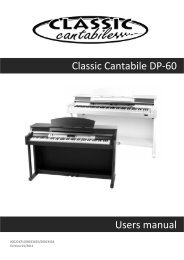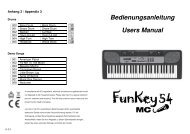Pronomic PMX-1804FX Users manual - Musikhaus Kirstein
Pronomic PMX-1804FX Users manual - Musikhaus Kirstein
Pronomic PMX-1804FX Users manual - Musikhaus Kirstein
Create successful ePaper yourself
Turn your PDF publications into a flip-book with our unique Google optimized e-Paper software.
<strong>PMX</strong> Series Mixer<br />
LINE IN<br />
MIC<br />
+10 +10 -40 +60<br />
TRIM<br />
dB/dBu<br />
0<br />
-15 +15<br />
0<br />
-15 +15<br />
0<br />
-15 +15<br />
BAL<br />
OR<br />
UNBAL<br />
LOW CUT<br />
75Hz<br />
18 dB/Oct<br />
Fig. 2.1: Connectors and<br />
controls of mic/line inputs<br />
EQ<br />
HIGH<br />
12 KHz<br />
MID<br />
2.5 KHz<br />
LOW<br />
80 Hz<br />
1<br />
MIC<br />
2.1 Mono channels<br />
2.1.1 Microphone and line inputs<br />
Each mono input channel offers a balanced microphone<br />
input via the XLR connector and also features switchable<br />
+48V phantom power supply for condenser microphones.<br />
The <strong>PMX</strong> preamps provide undistorted and noised-free gain<br />
as is typically known only from costly outboard preamps.<br />
Please mute your play back system before you<br />
active the phantom power supply to prevent switchon<br />
thump being directed to your loudspeakers.<br />
Please also note the instructions in chapter 2.4.2<br />
“Voltage supply, phantom power and fuse”.<br />
LINEIN<br />
Each mono input also features a balanced line input on a<br />
1/4" connector. Unbalanced devices (mono jacks) can also<br />
be connected to these inputs.<br />
please remember that you can only use either the<br />
microphone or the line input of a channel at any one<br />
time. You can never use both simultaneously!<br />
LOW CUT<br />
The mono channels of the mixing consoles have a highslope<br />
LOW CUT filter for eliminating unwanted,low-frequenty<br />
signal components (75 Hz, 18 dB/octave).<br />
TRIM<br />
Use the TRIM control to adjust the input gain. This control should always be turned fully counterclockwise<br />
whenever you connect or disconnect a signal source to one of the inputs.<br />
2.1.2 Equalizer<br />
All mono input channels include a 3-band equalizer. All bands provide boost or cut of up to 15dB. In the<br />
central position, the equalizer is inactive.<br />
The circuitry of the British EQs is based on the technology used in the bast-known top-of-the-line<br />
consoles and providing a warm sound without any unwanted side effects. The result are extremely musical<br />
equalizes which, unlike simple equalizers, cause no side effects such as phase shifting or bandwidth<br />
limitation, even with extreme gain settings of ±15 dB.<br />
Fig. 2.2: Panorama and routing controls<br />
4<br />
The upper (HI) and the lower band (LO) are shelving<br />
filters that increase or decrease all frequencies above<br />
or below their cut-off frequency. The cut-off frequencies<br />
of the upper and lower band are 12 kHz and 80 Hz<br />
respectively. The mid band is configured as a peak filter<br />
with a centre frequency of 2.5kHz<br />
FX<br />
FOOTSW<br />
PHONES<br />
CLIP<br />
-3<br />
-6<br />
-10<br />
-15<br />
-20<br />
LEVEL<br />
SPEAK OUTPUTS<br />
Min load 4Ω<br />
L<br />
R<br />
Fig. 2.16: AMP output<br />
DO NOT OBSTRUCT AIR VENTS<br />
Fig. 2.17: Heat removal system<br />
2 4 - BIT MULTI - FX PROCESSOR<br />
00 SMALL HALL<br />
03 MID HALL<br />
06 BIG HALL<br />
09 CHURCH<br />
10 SMALL ROOM<br />
13 MID ROOM<br />
16 BIG ROOM<br />
19 CHAPEL<br />
20 PLATE<br />
27 SPRING<br />
30 GATED REV<br />
24-BIT DUAL ENGINE DSP<br />
24-BIT A/D & D/A CONVERTER<br />
36 REVERSE<br />
40 EARLY REFL<br />
44 AMBIENCE<br />
48 STADIUM<br />
49 AMBIENCE FX<br />
50 DELAY<br />
59 ECHO<br />
60 CHORUS<br />
66 FLANGER<br />
70 PHASER<br />
74 PITCH SHIFT<br />
80 CHORUS & REVERB<br />
82 FLANGER & REVERB<br />
84 PHASER & REVERB<br />
86 PITCH & REVERB<br />
88 DELAY & REVERB<br />
90 DELAY & GATED<br />
91 DELAY & REVERSE<br />
92 DELAY & CHORUS<br />
94 DELAY & FLANGER<br />
96 DELAY & PHASER<br />
98 DELAY & PITCH<br />
PROGRAM<br />
(PUSH)<br />
Fig. 3.1: Digital effects module<br />
-2<br />
+1<br />
+2<br />
-1<br />
<strong>PMX</strong> Series Mixer<br />
AMP OUTPUT<br />
This speakon socket is for stereo Amp L/R output. It's<br />
used to connect speaker cabinet by speakon NL 4FC.<br />
Note: Min Load 4Ω<br />
2.4.3 AMP Output<br />
2.4.4 Heat removal system<br />
HEAT REMOVAL SYSTEM<br />
This is the mixer's stereo amp fan refrigeration system.<br />
It works with low speed in normal temperature (≤45℃).<br />
When it is higher than 45℃, it will quicken up.<br />
Note: Keep the windhole free, or the equipment will be too<br />
hot and turn to protection in advance.<br />
After the phantom power supply has been switched on, do not connect microphones to the<br />
mixer (or the stagebox/wallbox). Connect the on. In addition, the monitor/PA loudspeakers<br />
should be muted before activating the phantom power supply. After switching on, wait approx.<br />
One minute to allow the system to Stabilize.<br />
Caution! You must never use unbalanced XLR connectors (PIN 1and 3 connected) on the<br />
MIC input connectors if you want to use the phantom power supply.<br />
SERIAL NUMBER<br />
Please note the important information on the serial number given in chapter 1.3.3.<br />
3.DIGITAL EFFECTS PROCESSOR<br />
24-BIT MULTI-EFFECTS PROCESSOR<br />
Here you can find a list of all presets stored in the multieffects<br />
processor. This built-in effects module produces<br />
high-grade standard effects such as reverb, chorus, flanger,<br />
delay and various combination effects. The integrated<br />
effects module has the advantage of requiring no wiring.<br />
This way, the danger of creating ground loops or uneven<br />
signal level is eliminated at the outset, completely simplifying<br />
the handing.<br />
These effect presets are designed to be added to dry<br />
signals. If you move the FX TO MAIN control, you mix the<br />
channel signal (dry) and the effect signal.<br />
13
















